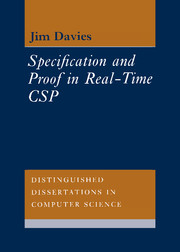8 - Broadcast communication
Published online by Cambridge University Press: 04 August 2010
Summary
SIGNALS
When describing the behaviour of a real-time process, we may wish to include instantaneous observable events that are not synchronisations. These signals may make it easier to describe and analyse certain aspects of behaviour, providing useful reference points in a history of the system. For example, an audible bell might form part of the user interface to a telephone network, even though the bell may ring without the cooperation of the user. This is incompatible with our existing view of communication.
In some cases, suitable environmental assumptions will allow us to describe such behaviour within the existing timed failures model. However, if we intend that these signals should be used to trigger other events or behaviours, then we must extend our semantic model to include an element of broadcast communication: some output events may occur without the cooperation of the environment.
In our model, signal events will occur as soon as they become available, and will propagate through parallel combination. A process may ignore any signal â performed by another process, unless it is waiting to perform the corresponding synchronisation a. If this is the case, then both â and a will occur. Of these, only the signal will be observed outside the parallel combination; it makes no sense to propagate a synchronisation.
- Type
- Chapter
- Information
- Specification and Proof in Real Time CSP , pp. 145 - 166Publisher: Cambridge University PressPrint publication year: 1993

